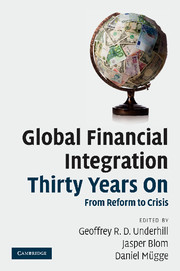Book contents
- Frontmatter
- Contents
- List of figures
- List of tables
- Notes on contributors
- Preface
- Acknowledgements
- List of abbreviations
- Introduction: the challenges and prospects of global financial integration
- Part I History and context: input, output and the current architecture (whence it came)
- Part II Assessing the current financial architecture (how well does it work?)
- Part III Does the future hold? Reactions to the current regime and prospects for progress (where is it going?)
- Conclusion: whither global financial governance after the crisis?
- References
- Index
Introduction: the challenges and prospects of global financial integration
Published online by Cambridge University Press: 02 December 2010
- Frontmatter
- Contents
- List of figures
- List of tables
- Notes on contributors
- Preface
- Acknowledgements
- List of abbreviations
- Introduction: the challenges and prospects of global financial integration
- Part I History and context: input, output and the current architecture (whence it came)
- Part II Assessing the current financial architecture (how well does it work?)
- Part III Does the future hold? Reactions to the current regime and prospects for progress (where is it going?)
- Conclusion: whither global financial governance after the crisis?
- References
- Index
Summary
The bitter winds of financial crisis have once again swept global markets, this time beginning at the core of the system, Wall Street. Whether blame be assigned to private greed, public policy lapses, or both, vast sums of public money and shareholder capital have been wiped out in the otherwise noble cause of preventing systemic breakdown. Vulnerable citizens once more count the costs to the real economy. As massive liquidity has been made available to private financial institutions on exceptionally permissive terms, it has been difficult not to notice the striking contrast with the management of earlier crises based in the emerging markets. When they were in the dock, the emphasis was on the conditionality of the terms of rescue; with Wall Street and the City in trouble, the terms of rescue have been much more open-ended.
As growing uncertainty combined with these apparent double standards, the crisis has reopened debate on the global financial architecture, public policy and regulation. Global financial integration and the governance of the global monetary and financial system stand at a crossroads after over thirty years of market-oriented cross-border integration and development preceded and indeed exacerbated a financial crisis on a scale not seen since the 1930s. This ongoing process of integration, regularly punctuated by crises and instability, raises analytical, normative and policy dilemmas which challenge our current understanding of financial and monetary governance.
- Type
- Chapter
- Information
- Global Financial Integration Thirty Years OnFrom Reform to Crisis, pp. 1 - 22Publisher: Cambridge University PressPrint publication year: 2010
- 2
- Cited by

